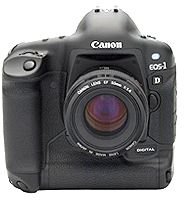Sony Ericsson K800i Mobile Phone vs
Canon 350D / 18-55mm EF-S vs
Canon 5D / Tamron 28-75mm f2.8
7x5 inch print comparison test


 Remember this? In July 2001, the Canon EOS 1D was a hot camera. Every image captured in its beautifully sculpted body measured a giddy 2464 x 1648 pixels. There was a preview screen on the back that crammed 120,000 pixels into two inches so you could see what you'd shot (almost) straight away. And you could change ISO from shot-to-shot - imagine that! At the time, Luminous Landscape was probably quite right to exclaim: "There's no doubt that the 1D is worth . . . $5,500".
Remember this? In July 2001, the Canon EOS 1D was a hot camera. Every image captured in its beautifully sculpted body measured a giddy 2464 x 1648 pixels. There was a preview screen on the back that crammed 120,000 pixels into two inches so you could see what you'd shot (almost) straight away. And you could change ISO from shot-to-shot - imagine that! At the time, Luminous Landscape was probably quite right to exclaim: "There's no doubt that the 1D is worth . . . $5,500".
 In July 2006, a Sony Ericsson K800i dropped through my letterbox. It shoots images of 2048 x 1365 pixels, and has a 2 inch live preview TFT screen – with 262,000 pixels. It has a 35mm f2.8 prime lens, autofocus, internal storage for 80 images, a Xenon flash and IS (Image Stabilising). And it was free.
In July 2006, a Sony Ericsson K800i dropped through my letterbox. It shoots images of 2048 x 1365 pixels, and has a 2 inch live preview TFT screen – with 262,000 pixels. It has a 35mm f2.8 prime lens, autofocus, internal storage for 80 images, a Xenon flash and IS (Image Stabilising). And it was free.
The fact that it shoots video; presents films; receives FM; marshalls a library of 300 MP3s; plays games; accesses the web; retrieves email; runs Java; vibrates; is a calendar, stopwatch, organiser, alarm clock, calculator, database, jukebox – and phone – is a bonus in something that weighs less than a pancake lens.
At the time of writing (at least until the Nokia N93, with its Zeiss zoom lens, becomes available), this is pretty much the best camera phone money can buy – or, in my case, not: because it was free with my 02 contract. If you really want to know all about it, here's Sony's developer white paper.
Up against it in this comparative test are the 8MP Canon 350D with the 18-55mm kit lens, and the 13MP full frame Canon 5D with the excellent Tamron 28-75mm f2.8.
The aim of the game here is to produce the best possible 7x5 inch print from each camera, with corresponding framing and depth of field. In the case of the K800i that meant shooting at f2.8; the grown-ups were at f8. To retain the bigger sensors' advantage, colour correction and sharpening were performed on the highest resolution captures, then downsampled using Photoshop Bicubic Sharper for maximum quality.
To reiterate: for 90% of all the photographs ever taken, the production of a 7x5" print is the only meaningful assessment made of a camera's imaging performance.
This, then, is how they compare . . . .